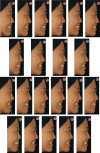Effect of maxillary incisor labiolingual inclination and anteroposterior position on smiling profile esthetics
- PMID: 20936964
- PMCID: PMC8926362
- DOI: 10.2319/033110-181.1
Effect of maxillary incisor labiolingual inclination and anteroposterior position on smiling profile esthetics
Abstract
Objective: To test the null hypothesis that there is no effect of maxillary incisor labiolingual inclination and anteroposterior (AP) position on smiling profile esthetics in young adult females.
Materials and methods: A facial smiling profile photograph of a Chinese woman with a normal profile, a Class I occlusion, and a Class I skeletal pattern was digitized. The digital image was modified to obtain four series comprising 29 smiling profiles. The sample of individuals rating these pictures comprised 21 orthodontic professionals and 66 undergraduates. Post hoc tests were done with the Student Newman Keuls method to analyze the data.
Results: Significant differences (P < .001) were detected when each photograph's ratings were compared. The smiling profile with the highest score was the one with 5° lingual inclination, while the ones with 15° labial inclination or 4-mm retrusion had lower scores than the others. Maxillary incisor protrusion and lingual inclination were preferable compared with retruded or flared incisors. There was no significant discrepancy between the professional and nonprofessional groups in terms of their assessments.
Conclusions: The hypothesis is rejected. Both maxillary incisor labiolingual inclination and AP position play an essential role in the esthetics of the smiling profile. However, when formulating treatment plans, dentists should never underestimate the labiolingual inclination's influence on the smiling profile.
Figures




References
-
- Andrews W. A. AP relationship of the maxillary central incisors to the forehead in white females. Angle Orthod. 2008;78:662–669. - PubMed
-
- Dorsey J, Korabik K. Social and psychological motivations for orthodontic treatment. Am J Orthod. 1977;72:460–467.
-
- Kilpelanien P, Phillips C, Tulloch J. F. C. Anterior tooth position and motivation for early treatment. Angle Orthod. 1993;63:171–174. - PubMed
-
- Isıksal E, Hazar S, Akyalçın S. Smile esthetics: perception and comparison of treated and untreated smiles. Am J Orthod Dentofacial Orthop. 2006;129:8–16. - PubMed
-
- Schlosser J. B, Preston C. B, Lampasso J. The effects of computer-aided anteroposterior maxillary incisor movement on ratings of facial attractiveness. Am J Orthod Dentofacial Orthop. 2005;127:17–24. - PubMed
Publication types
MeSH terms
LinkOut - more resources
Full Text Sources

